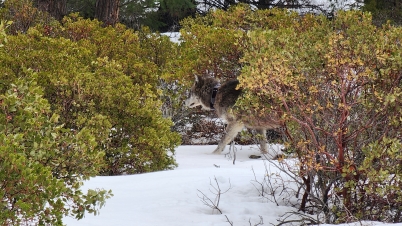Wolf conflicts rise as funding to pay ranchers runs dry

Photo / California Department of Fish and Wildlife

By Ching Lee
Less than a year after the state fully implemented a pilot program to compensate ranchers for livestock losses and other economic impacts caused by wolves, the California Department of Fish and Wildlife says it has run out of money.
The announcement earlier this month came as no surprise to ranchers, who say the $3 million allocated for the program does not begin to pay for the rising economic damage created by the presence of wolves, apex predators protected under state and federal endangered species acts.
Ranchers also expressed frustration with how the program has been administered and managed. Some who have received reimbursement checks said they did not get the full amount they applied for and don’t know why, as the department did not provide a reason or a way for ranchers to dispute the decision. Others with pending applications said they continue to wait with no idea as to the status of their claims.
To mitigate wolf-related costs to ranchers, the Legislature authorized funding in the 2021-22 state budget to establish what is considered the most comprehensive livestock loss compensation program in the country. It pays for: fair market value of confirmed and probable livestock loss due to wolf attacks; use of nonlethal tools to deter wolf depredation; and production losses associated with wolves being around livestock, also known as “pay for presence.”
CDFW rolled out the first two parts of the program—compensation for livestock loss and deterrence—in 2022. Pay for presence was implemented last spring. Compensation is retroactive from Sept. 23, 2021 through June 20, 2026, or when funds run out.
In its announcement, the department said it had received 102 applications and that there may not be enough money to cover future applications.
Multiple attempts were made to CDFW for comment, but department officials said they did not have enough time to respond to questions from Ag Alert® over a 13-day period.
In an email, spokesman Peter Tira said, “Please understand that our wolf program is an extremely high-profile program that receives national and international attention and scrutiny so we need to make sure our responses are accurate, complete and thorough.”
Considering the state’s expanding wolf populations—from the first known wolf pack in Shasta County in 2015 to the seven confirmed packs today in Lassen, Plumas, Tehama and Tulare counties—ranchers agree more funds are needed as more wolf-livestock conflicts occur.
“I don’t want to sound ungrateful, but this kind of compensation doesn’t even come close,” said Tehama County rancher Billie Roney, who runs cattle with her husband Wally in forest allotments in Lassen County where they have had most of their wolf conflicts.
Ranchers say direct wolf kills are not the most expensive cost of living with wolves. The greater cost, they say, is in their animals’ weight loss and poor pregnancy rates due to stress and being chased around by wolves. Add to that the expenses they incur trying to protect their livestock.
Roney said she and her husband were forced to leave their grazing allotments, even though the land had plenty of feed, because of wolf conflicts. In addition to buying extra hay, they also had to pay for hauling and moving their cattle away from the wolves. The couple applied for reimbursement of $49,000 for losses in 2021 and $50,000 for 2022. They received checks for $27,000 and $29,000.
Ken Tate, University of California, Davis, specialist in rangeland watershed sciences, said he has heard “a lot of complaints” about how the compensation program has been handled. He and Tina Saitone, UC Davis rangeland and livestock economist, are two years into a four-year study quantifying the costs California ranchers incur trying to manage livestock around wolves.
He said what limited research there is from the few states with wolf populations indicates that the indirect costs to ranchers are as much as seven and a half times greater than the cost of animals lost to wolf kill. The costs are certain to increase as wolf populations grow. He estimated there could be 200 wolves in the state in another decade. Current estimates range from at least 30 to fewer than 50.
Because Tate and Saitone have been helping ranchers with their compensation applications, Tate said they knew immediately the $3 million would be spent quickly. With cattle prices at an all-time high, his rough calculation showed all funding would be expended in a year just on the pay-for-presence claims. He said he thinks more than $2 million of the current funds are going to nonlethal deterrence costs from 2021 and 2022.
Based on Tate and Saitone’s estimates, Paul Roen, a Sierra County rancher and supervisor who serves on the California Cattlemen’s Association’s wolf committee, said the association has asked the state for an annual $15 million to continue funding the program. But “so far, I think that’s fell on deaf ears,” he said.
Roen has not been able to apply for compensation for wolf presence because he’s considered outside the wolf core areas eligible for reimbursement, even though there are now 12 documented wolves in his area, with local ranchers dealing with multiple wolf-livestock interactions, he said.
“That is where the frustration is: (CDFW) won’t even commit to how they’re going to adjust their areas or what they’re doing. They tell you, ‘We do the map once a year.’ Well, the wolves don’t stay in one spot for a year,” he said. And the packs are “rapidly” expanding, he pointed out.
Tate served on a CDFW stakeholders advisory committee during the development of the compensation program, and he said the committee gave the department suggestions on how the program should run. He said he was disappointed when the department dissolved the committee and appeared to ignore its input.
“They wouldn’t listen to anything anybody said,” Tate said. “They’re still having a hard time admitting that wolves are killing cattle.”
Tate said ranchers and wildlife advocates agree on one priority: There should be more wolves outfitted with GPS collars to get a better handle on their population and whereabouts. Of the seven documented packs, CDFW has indicated five wolves have been collared.
Plumas County rancher Brian Kingdon said he has been dealing with two different wolf packs—the Lassen pack in Plumas and Lassen counties and an unnamed Lassen County pack known locally as the Beyem Seyo pack. The latter is about a few miles from his house, and he can hear them howling at night.
Because wolves are protected, ranchers are prohibited from killing, harming or harassing them. Kingdon said he has no recourse when they come near his cattle other than to shine a light at them to get them to leave.
Kingdon said he has not applied for compensation on any actual wolf kills, noting sometimes calves disappear and can’t be confirmed because they’ve been fully consumed. He received compensation for 2021 and 2022 expenses related to deterrence efforts and wolf presence, but the amounts were about 40% of what he applied for. There was no explanation, he said, and the checks did not indicate which applications they cover.
“It would be nice to know which years those were,” Kingdon said, noting he would need that information when he files his taxes.
Siskiyou County rancher Jeff Fowle submitted his application last January for expenses related to the loss of two livestock guardian dogs he had to replace in 2022. He also applied for the cost of extra hours worked locking up his cattle in pens to protect them from wolves. His application, he said, “continues to sit somewhere in space, still waiting to be paid.” With program monies exhausted, he said he’s not optimistic the state will appropriate more funding.
“Those of us on the ground knew that it was a poorly planned effort,” he said.
Even if more funds are allocated, the compensation program remains controversial in the ranching community.
Some ranchers view the payments as a move by conservation groups to downplay and quiet their concerns and grievance about the impact of wolves on their livestock and to get ranchers to accept the presence of wolves.
“We didn’t want compensation because it was like giving in, and we weren’t ready yet,” said Rick Roberti, a rancher in Plumas and Sierra counties.
But even those who remain opposed to the program say they have no choice but to accept the payments to help offset some of the financial losses they have suffered.
“I’m a hypocrite to even take the compensation because I was against it for a long time,” Kingdon of Plumas County said. “I feel that (wolves) have to be managed—and not just with compensation.”
Roen of Sierra County said if ranchers are expected to coexist with wolves, the state needs to step up funding for the program and make it sustainable. The ranching community has been “trying to put their best foot forward,” he said, but if the state chooses to “quit playing ball,” it could put ranchers “in a precarious position.”
“People love their animals,” he said, “and they’re not going to sit there and watch them get devastated.”
(Ching Lee is an assistant editor of Ag Alert. She may be contacted at clee@cfbf.com.)




